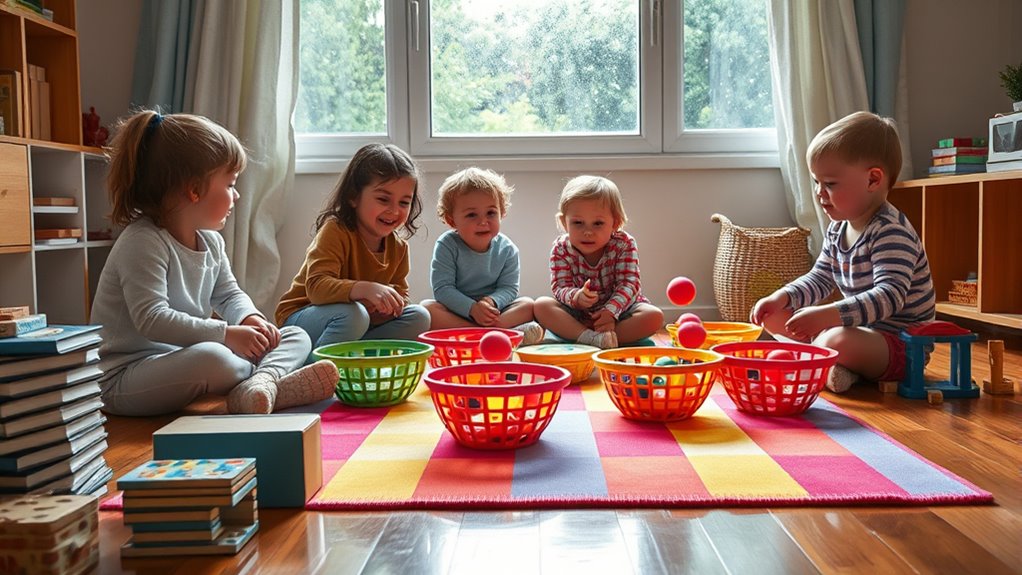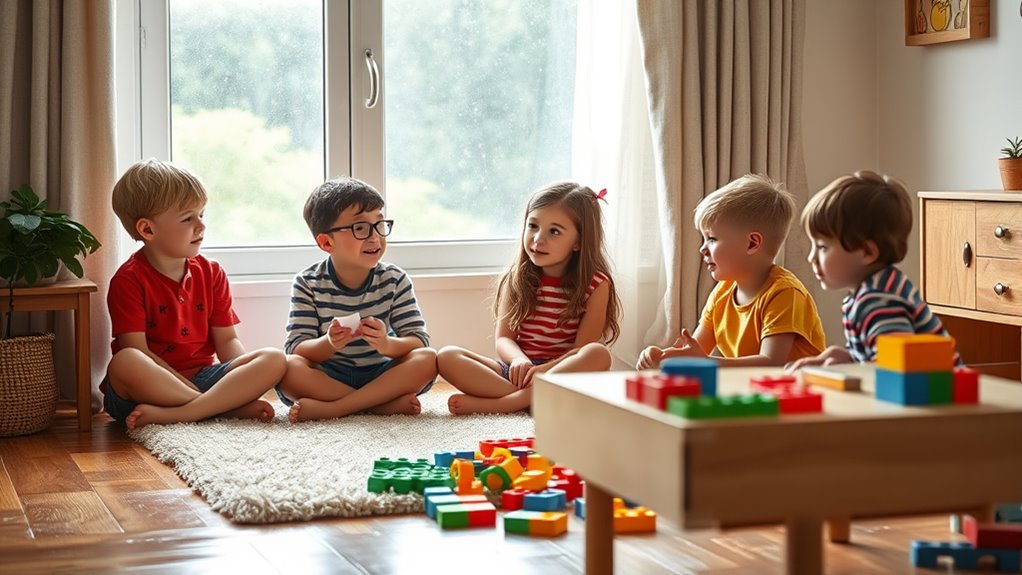On rainy days, you can boost your family’s skills with fun indoor games like creative storytelling and memory matching. These activities develop imagination, language, memory, and concentration while keeping everyone engaged. They require minimal setup and are adaptable for all ages, turning gloomy days into opportunities for learning and bonding. If you want to discover more ideas and tips, keep exploring options to make indoor play both educational and entertaining.
Key Takeaways
- Creative storytelling enhances language skills, imagination, and teamwork in a fun indoor setting.
- Memory matching games improve memory, concentration, pattern recognition, and mental agility.
- Both activities require minimal setup, making them accessible for all age groups indoors.
- These games foster communication, active listening, and collaborative thinking among participants.
- They turn rainy days into educational opportunities that develop cognitive and social skills.

When rain keeps you indoors, it can be challenging to keep everyone entertained and energized. One fantastic way to do this is by engaging in games that not only pass the time but also build important skills. Creativity and memory are two essential areas that can be strengthened through fun activities like creative storytelling and memory matching. These games are perfect for a rainy day because they encourage imagination and mental sharpness, all while keeping the mood lively.
Starting with creative storytelling, this game invites everyone to participate in crafting a story together. You can begin with a simple prompt, such as “Once upon a time, in a mysterious castle…” and then take turns adding sentences or elements to the story. This activity sparks imagination and helps develop language skills, vocabulary, and the ability to think on your feet. It also encourages kids to listen carefully and build upon each other’s ideas, fostering teamwork and communication. Plus, it’s adaptable for all ages—whether you’re involving preschoolers or teenagers. To make it more engaging, you can introduce themed storytelling, like spooky tales or adventure stories, or even use props or pictures to inspire the narrative. Food preservation methods like canning or fermenting can also be incorporated into storytelling to make the stories more thematic and educational. Creative storytelling is a versatile indoor game that keeps minds active and sparks laughter and wonder.
Create stories together to boost imagination, language skills, and teamwork on rainy days.
Another excellent indoor game that promotes mental agility is memory matching. This game involves laying out pairs of cards or pictures face down and taking turns flipping two over, trying to find matching pairs. It’s simple but effective at boosting memory, concentration, and pattern recognition. To up the challenge, you can create your own cards with family photos, favorite characters, or themed images related to a current interest or lesson. Memory matching is perfect for younger children learning to recognize similarities and differences, but it also benefits older kids and adults by sharpening their focus and recall skills. Playing regularly helps improve short-term memory and enhances visual scanning abilities. Plus, it’s a quiet, low-pressure game that can be played at a table or on the floor, making it ideal for confined indoor spaces during a rainy day.
Both creative storytelling and memory matching are easy to set up, require minimal equipment, and are adaptable for different ages and skill levels. They turn a gloomy day into a productive, fun-filled experience that promotes essential cognitive skills. As you gather everyone around, you’ll find these games not only keep boredom at bay but also nurture creativity, memory, and teamwork—all without needing to step outside. So next time the rain keeps you indoors, remember that you can turn the stormy weather into an opportunity for engaging, skill-building play.
Frequently Asked Questions
How Can I Adapt Indoor Games for Different Age Groups?
To adapt indoor games for different age groups, you should incorporate age-appropriate modifications and multi-skill adaptations. For younger children, simplify rules and focus on basic skills, while for older kids, introduce more complex challenges. Use multi-skill adaptations by combining physical, cognitive, and social elements to keep everyone engaged. Adjust the pace and difficulty level to suit each age group, ensuring all players stay motivated and develop their abilities.
What Safety Precautions Should I Consider During Indoor Play?
You should prioritize indoor safety by ensuring a secure play area setup, removing sharp or fragile objects, and using non-slip mats. Always supervise children closely to prevent accidents and encourage safe play. Check that furniture is stable, and avoid overcrowding to reduce falls or collisions. Keep emergency contacts handy and teach kids about safe play boundaries. These precautions help create a fun, secure environment for everyone during indoor activities.
Are There Educational Benefits Beyond Skill Development?
Think of indoor games as more than just fun—they’re like treasure chests of learning. By engaging in these activities, you boost your child’s cognitive advantages and emotional growth. These games encourage problem-solving, creativity, and teamwork, helping your child develop essential social and emotional skills. Beyond skill-building, they foster resilience and confidence, making every rainy day a valuable opportunity for holistic growth and learning that lasts a lifetime.
How Can I Encourage Shy Children to Participate?
To encourage shy children to participate, start with trust-building activities that make them feel safe and comfortable. Use confidence-boosting strategies like gentle praise and small group games to gradually increase their comfort level. You can also offer choices to give them control, and always respect their pace. By creating a supportive environment, you help shy children feel more willing to join in and develop social skills naturally.
What Are Budget-Friendly Indoor Game Options?
When you’re on a budget, you can still keep the fun flowing with DIY puzzles and indoor obstacle courses. These activities are budget-friendly and spark creativity. You can create puzzles from cardboard or old magazines, and design obstacle courses using household items like cushions and chairs. These games keep kids engaged, active, and developing skills without breaking the bank, proving that good times come at a low cost.
Conclusion
Next time rain keeps you indoors, try these games to build skills and have fun. Think of them as a way to strengthen your mind and body, much like a workout for your brain. Visualize your ideas as a colorful map, each game adding a new detail or connection. Just like a painter creates a masterpiece, you’re crafting a well-rounded, sharp, and creative mind through these indoor activities. So, embrace the rain and play your way to growth!









